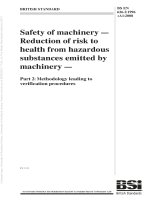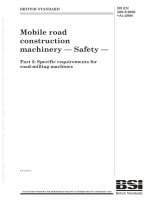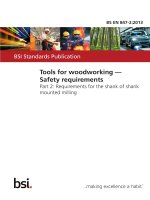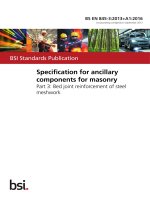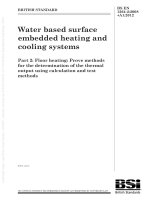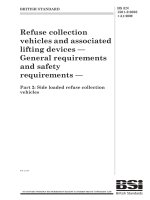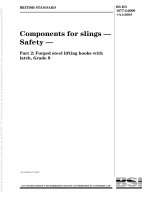Bsi bs en 00845 2 2013 + a1 2016
Bạn đang xem bản rút gọn của tài liệu. Xem và tải ngay bản đầy đủ của tài liệu tại đây (1.63 MB, 50 trang )
BS EN 845-2:201 3+A1 :201 6
In corpora tin g corrigen dum September 201 3
BSI Standards Publication
Specification for ancillary
components for masonry
Part 2: Lintels
BS EN 845-2:201 3+A1 :201 6
BRITISH STANDARD
National foreword
This British Standard is the UK implementation of
EN 845-2:201 3+A1 :201 6. It supersedes BS EN 845-2:201 3 which
is withdrawn.
The start and finish of text introduced or altered by amendment
is indicated in the text by tags. Tags indicating changes to CEN
text carry the number of the CEN amendment. For example, text
altered by CEN amendment A1 is indicated by
.
!"
EN 845-2 specifies the characteristics and performance requirements
for lintels available throughout the CEN member countries. It aims
to do so in product performance terms, avoiding as far as possible
prescriptive requirements and all the traditional designations of
lintels available throughout Europe.
EN 845-2 includes clauses covering initial type tests, factory
production control, sampling for initial type testing and
independent testing of consignments. These are similar in all
masonry product specifications.
The UK National Annex NA attached to this standard provides an
informative commentary on EN 845-2. Nothing in this annex should
be construed as specifying requirements other than those contained
in the normative parts of this European Standard.
If CE marking is performed, the procedures in Annex ZA will apply.
The significance of the CE marking is that the product manufacturer
claims compliance with the “harmonized” requirements given in the
normative text of the product standard. These relate to the basic
requirements for construction works as given in the Construction
Products Regulation. Not all product characteristics need necessarily
be given on the CE marking, but those product characteristics
covered by regulations in force in each EU Member State, where the
manufacturer intends that the product will be used, do need to be stated.
The UK participation in its preparation was entrusted by Technical
Committee B/51 9, Masonry and associated testing, to Subcommittee
B/51 9/3, Ancillary components.
A list of organizations represented on this subcommittee can be
obtained on request to its secretary.
This publication does not purport to include all the necessary
provisions of a contract. Users are responsible for its correct
application.
© The British Standards Institution 201 6.
Published by BSI Standards Limited 201 6
ISBN 978 0 580 84583 3
ICS 91 .060.1 0; 91 .080.30
Compliance with a British Standard cannot confer immunity from
legal obligations.
This British Standard was published under the authority of the
Standards Policy and Strategy Committee on 31 August 201 3.
Amendments/corrigenda issued since publication
Date
Text affected
30 September 201 3
Correction to supersession details
30 September 201 6
Implementation of CEN amendment A1 :201 6.
National foreword and National Annex NA updated
EUROPEAN STANDARD
EN 845-2:2013+A1
NORME EUROPÉENNE
EUROPÄISCHE NORM
July 2016
ICS 91.080.30
Supersedes EN 845-2:2013
English Version
Specification for ancillary components for masonry - Part
2: Lintels
Spécifications pour composants accessoires de
maỗonnerie - Partie 2: Linteaux
Festlegungen fỹr Ergọnzungsbauteile fỹr Mauerwerk Teil 2: Stürze
This European Standard was approved by CEN on 21 March 2013 and includes Amendment 1 approved by CEN on 9 April 2016.
CEN members are bound to comply with the CEN/CENELEC Internal Regulations which stipulate the conditions for giving this
European Standard the status of a national standard without any alteration. Up-to-date lists and bibliographical references
concerning such national standards may be obtained on application to the CEN-CENELEC Management Centre or to any CEN
member.
This European Standard exists in three official versions (English, French, German). A version in any other language made by
translation under the responsibility of a CEN member into its own language and notified to the CEN-CENELEC Management
Centre has the same status as the official versions.
CEN members are the national standards bodies of Austria, Belgium, Bulgaria, Croatia, Cyprus, Czech Republic, Denmark, Estonia,
Finland, Former Yugoslav Republic of Macedonia, France, Germany, Greece, Hungary, Iceland, Ireland, Italy, Latvia, Lithuania,
Luxembourg, Malta, Netherlands, Norway, Poland, Portugal, Romania, Slovakia, Slovenia, Spain, Sweden, Switzerland, Turkey and
United Kingdom.
EUROPEAN COMMITTEE FOR STANDARDIZATION
C O M I TÉ E URO PÉ E N D E N O RM ALI S ATI O N
E URO PÄI S C H E S KO M I T E E FÜR N O RM UN G
CEN-CENELEC Management Centre: Avenue Marnix 17, B-1000 Brussels
© 2016 CEN
All rights of exploitation in any form and by any means reserved
worldwide for CEN national Members.
Ref. No. EN 845-2:2013+A1:2016 E
BS EN 845-2:2013+A1:2016
EN 845-2:2013+A1:2016 (E)
Contents
Page
European foreword ....................................................................................................................................................... 4
1
Scope .................................................................................................................................................................... 5
2
Normative references .................................................................................................................................... 5
3
3.1
3.2
Terms, definitions and symbols ................................................................................................................. 6
Terms and definitions ................................................................................................................................... 6
Symbols ............................................................................................................................................................... 8
4
4.1
4.2
4.3
4.4
Materials .......................................................................................................................................................... 11
Steel lintels ..................................................................................................................................................... 11
Concrete lintels ............................................................................................................................................. 11
Masonry lintels .............................................................................................................................................. 12
Combined and composite lintels ............................................................................................................ 13
5
5.1
5.2
5.2.1
5.2.2
5.2.3
5.2.4
5.3
Requirements ................................................................................................................................................ 13
General ............................................................................................................................................................. 13
Dimensions, mass and limit deviations ................................................................................................ 13
Dimensions ..................................................................................................................................................... 13
Mass per unit area ........................................................................................................................................ 14
Built-in length ................................................................................................................................................ 14
Deviation from declared values .............................................................................................................. 14
Mechanical performance and information to obtain the mechanical
performance ................................................................................................................................................... 14
5.3.1 Single lintels, combined lintels and composite lintels .................................................................... 14
5.3.2 Prefabricated part of composite lintels ............................................................................................... 15
5.4
Durability ........................................................................................................................................................ 16
5.4.1 General ............................................................................................................................................................. 16
5.4.2 Steel lintels ..................................................................................................................................................... 16
5.4.3 Concrete lintels and masonry lintels .................................................................................................... 16
5.5
Water penetration and installation ....................................................................................................... 16
5.6
Thermal properties ..................................................................................................................................... 16
5.7
Freeze/thaw resistance ............................................................................................................................. 17
5.7.1 General ............................................................................................................................................................. 17
5.7.2 Steel lintels ..................................................................................................................................................... 17
5.7.3 Concrete lintels ............................................................................................................................................. 17
5.7.4 Masonry lintels .............................................................................................................................................. 17
5.8
Resistance to fire .......................................................................................................................................... 17
5.9
Water absorption ......................................................................................................................................... 17
5.9.1 General ............................................................................................................................................................. 17
5.9.2 Steel lintels ..................................................................................................................................................... 17
5.9.3 Other lintels.................................................................................................................................................... 18
5.10 Water vapour permeability ...................................................................................................................... 18
5.11 Dangerous substances ................................................................................................................................ 18
6
Description and designation .................................................................................................................... 18
7
Marking ............................................................................................................................................................ 21
2
BS EN 845-2:2013+A1:2016
EN 845-2:2013+A1:2016 (E)
8
8.1
8.2
8.2.1
8.2.2
8.2.3
8.2.4
8.3
8.3.1
8.3.2
8.3.3
8.3.4
Assessment and verification of constancy of performance - AVCP ............................................ 22
General ............................................................................................................................................................. 22
Type testing .................................................................................................................................................... 22
General ............................................................................................................................................................. 22
Test samples, testing and compliance criteria .................................................................................. 23
Test reports .................................................................................................................................................... 23
Shared other party results ........................................................................................................................ 23
Factory production control (FPC) .......................................................................................................... 24
General ............................................................................................................................................................. 24
Requirements ................................................................................................................................................ 25
Product specific requirements ................................................................................................................ 28
Procedure for modifications .................................................................................................................... 28
Annex A (informative) Method for assessment of loads on lintels ............................................................ 29
Annex B (informative) Recommendations for installation of lintels ....................................................... 30
B.1
Bearings ........................................................................................................................................................... 30
B.2
Installation ..................................................................................................................................................... 30
B.3
Composite lintels .......................................................................................................................................... 30
Annex C (normative) Corrosion protection systems ...................................................................................... 31
C.1
Steel lintels ..................................................................................................................................................... 31
C.2
Concrete and masonry lintels (except those manufactured using autoclaved
aerated concrete) ......................................................................................................................................... 33
C.3
Lintels manufactured using autoclaved aerated concrete ............................................................ 34
Annex D (informative) Guidance on FPC frequencies .................................................................................... 35
! Annexprovisions
ZA"
Clauses of this European Standard addressing the
of the EU Construction Products Regulation ................................................................ 37
(informative)
ZA.1
Scope and relevant characteristics ........................................................................................................ 37
ZA.2
System of Assessment and Verification of Constancy of Performance (AVCP) ...................... 40
ZA.3
Assignment of AVCP tasks ......................................................................................................................... 40
Bibliography ................................................................................................................................................................. 42
3
BS EN 845-2:2013+A1:2016
EN 845-2:2013+A1:2016 (E)
European foreword
This document (EN 845-2:2013+A1:2016) has been prepared by Technical Committee
CEN/TC 125 “Masonry”, the secretariat of which is held by BSI.
This European Standard shall be given the status of a national standard, either by publication of
an identical text or by endorsement, at the latest by January 2017, and conflicting national
standards shall be withdrawn at the latest by April 2018.
Attention is drawn to the possibility that some of the elements of this document may be the
subject of patent rights. CEN [and/or CENELEC] shall not be held responsible for identifying any
or all such patent rights.
This document includes Amendment 1 approved by CEN on 2016-04-09.
This document supersedes
! EN 845-2:2013 " .
!"
The start and finish of text introduced or altered by amendment is indicated in the text by tags
.
This document has been prepared under a mandate given to CEN by the European Commission
and the European Free Trade Association, and supports essential requirements of
EU Directive(s).
For relationship with EU Directive(s), see informative Annex ZA, which is an integral part of this
document.
! deleted text"
EN 845, Specification for ancillary components for masonry, consists of the following parts:
— Part 1 : Wall ties, tension straps, hangers and brackets
— Part 2: Lintels
— Part 3: Bed joint reinforcement of steel meshwork
According to the CEN/CENELEC Internal Regulations, the national standards organizations of
the following countries are bound to implement this European Standard: Austria, Belgium,
Bulgaria, Croatia, Cyprus, Czech Republic, Denmark, Estonia, Finland, Former Yugoslav Republic
of Macedonia, France, Germany, Greece, Hungary, Iceland, Ireland, Italy, Latvia, Lithuania,
Luxembourg, Malta, Netherlands, Norway, Poland, Portugal, Romania, Slovakia, Slovenia, Spain,
Sweden, Switzerland, Turkey and the United Kingdom.
4
BS EN 845-2:2013+A1:2016
EN 845-2:2013+A1:2016 (E)
1 Scope
This European Standard specifies requirements for prefabricated lintels for maximum spans of
4,5 m and made from steel, autoclaved aerated concrete, manufactured stone, concrete, fired
clay units, calcium silicate units, natural stone units, or a combination of these materials.
Concrete and steel beams conforming to EN 1090-1, EN 12602 and EN 13225, as appropriate,
are not covered by this standard.
Prefabricated lintels can be either complete lintels or the prefabricated part of a composite
lintel.
This European Standard is not applicable to:
a) lintels completely made on site;
b) lintels of which the tensile parts are made on site;
c)
timber lintels;
d) natural stone lintels, not reinforced.
Linear components spanning clear openings greater than 4,5 m in masonry walls and linear
components intended for use independently in a structural role (e.g. beams) are not covered by
this standard.
2 Normative references
The following documents, in whole or in part, are normatively referenced in this document and
are indispensable for its application. For dated references, only the edition cited applies. For
undated references, the latest edition of the referenced document (including any amendments)
applies.
EN 206-1:2000, Concrete — Part 1 : Specification, performance, production and conformity
EN 771 (all parts), Specification for masonry units
EN 772-1, Methods of test for masonry units — Part 1 : Determination of compressive strength
EN 772-11, Methods of test for masonry units — Part 1 1 : Determination of water absorption of
aggregate concrete, autoclaved aerated concrete, manufactured stone and natural stone masonry
units due to capillary action and the initial rate of water absorption of clay masonry units
EN 846-9, Methods of test for ancillary components for masonry — Part 9: Determination of
flexural resistance and shear resistance of lintels
EN 846-11, Methods of test for ancillary components for masonry — Part 11 : Determination of
dimensions and bow of lintels
EN 846-13:2001, Methods of test for ancillary components for masonry — Part 1 3: Determination
of resistance to impact, abrasion and corrosion of organic coatings
EN 846-14, Methods of test for ancillary components for masonry — Part 1 4: Determination of the
initial shear strength between the prefabricated part of a composite lintel and the masonry above
it
5
BS EN 845-2:2013+A1:2016
EN 845-2:2013+A1:2016 (E)
EN 990, Test methods for verification of corrosion protection of reinforcement in autoclaved
aerated concrete and lightweight aggregate concrete with open structure
EN 998-2:2010, Specification for mortar for masonry — Part 2: Masonry mortar
EN 1745, Masonry and masonry products — Methods for determining thermal properties
EN 10080, Steel for the reinforcement of concrete — Weldable reinforcing steel — General
EN 10088 (all parts), Stainless steels
prEN 10138 (all parts), Prestressing steels
EN 10346:2009, Continuously hot-dip coated steel flat products — Technical delivery conditions
EN 12602:2008, Prefabricated reinforced components of autoclaved aerated concrete
EN 13501-2, Fire classification of construction products and building elements —
Part 2: Classification using data from fire resistance tests, excluding ventilation services
EN ISO 1461, Hot dip galvanized coatings on fabricated iron and steel articles — Specifications
and test methods (ISO 1461 )
EN ISO 1463, Metallic and oxide coatings — Measurement of coating thickness — Microscopical
method (ISO 1 463)
3 Terms, definitions and symbols
3.1 Terms and definitions
For the purposes of this document, the following terms and definitions apply.
NOTE 1
Examples of lintel types are shown in Figures 1 to 3. The figures are only for illustration of
lintel types. Other details such as bearings, thermal insulation systems and damp proof courses are not
shown.
NOTE 2
General dimensions defined in Clause 3 are illustrated in Figures 3 and 4.
3.1.1
autoclaved aerated concrete lintel
lintel manufactured using reinforced autoclaved aerated concrete
3.1.2
bearing length
length of the end of a lintel which bears on its support
3.1.3
built-in length
minimum length needed to anchor the reinforcing bars
3.1.4
clear opening
clear distance between lintel supports
6
BS EN 845-2:2013+A1:2016
EN 845-2:2013+A1:2016 (E)
3.1.5
combined lintel
lintel consisting of two or more structural elements each one acting with compression and
tension zones
3.1.6
composite lintel
lintel comprising a prefabricated part and a complementary element of in-situ masonry or
concrete above, acting together
3.1.7
composite lintel height
overall height of the tension and compression zones of a composite lintel
3.1.8
concrete lintel
lintel manufactured using reinforced or prestressed concrete
3.1.9
declared value
value for a product property, determined in accordance with this standard, that a manufacturer
is confident of achieving, bearing in mind the variability of the manufacturing process
3.1.10
effective span
distance between the centres of the bearing of a lintel, or the clear opening spanned by the lintel
plus the overall height of the lintel including any complementary element, whichever is the
lesser
3.1.11
flexural resistance
mean uniformly distributed load at which failure of a sample of lintel specimens occurs (or a
lower load at which tests are stopped in accordance with the recommendations of the
manufacturer of the lintel)
3.1.12
lintel
lineal element supporting load over an opening in a masonry wall
3.1.13
lintel height
overall height of the prefabricated part of a lintel
3.1.14
lintel length
overall length of the prefabricated lintel
3.1.15
load bearing capacity
mean value for a sample of lintels of the total of the uniformly distributed load at failure or at an
extreme deflection, whichever is the lesser
7
BS EN 845-2:2013+A1:2016
EN 845-2:2013+A1:2016 (E)
3.1.16
load ratio
ratio of inner leaf load to outer leaf load on a lintel supporting a double-leaf or cavity wall
3.1.17
masonry lintel
lintel comprising one or more shell casing units completed by the incorporation within the shell
casing of reinforced or prestressed concrete
3.1.18
shear resistance
mean shear load at which failure of a sample of lintel specimens occurs (or a lower load at
which tests are stopped in accordance with the recommendations of the manufacturer of the
lintel)
3.1.19
shell casing unit
preformed component with one or more channels into which is incorporated either reinforced
or prestressed concrete
3.1.20
single lintel
prefabricated lintel acting alone
3.1.21
declared deflection
deflection at one third of the declared load capacity of the lintel
3.1.22
steel lintel
lintel manufactured from steel
3.1.23
structural shell casing unit
shell casing unit which is made of a material with a compressive strength not less than that of
the infill concrete
3.2 Symbols
NOTE
8
General dimensions are illustrated in Figures 3 and 4.
bs
is the smallest width of a structural shell casing unit specimen, in mm (see Figure 5);
b
is the bearing length, in mm;
dppcl
is the height of the prefabricated part of the composite lintel;
dc
is the composite lintel height, in mm;
dl
is the lintel height, in mm;
δdv
is the declared deflection in a vertical direction, in mm;
δdh
is the declared deflection in a horizontal direction, in mm;
hu
is the height of the masonry unit;
tbj
is the thickness of the bedjoint;
BS EN 845-2:2013+A1:2016
EN 845-2:2013+A1:2016 (E)
hs
is the cut length of a structural shell casing unit specimen, in mm (see Figure 5);
l
is the lintel length, in mm;
l0
is the clear opening, in mm;
l
e
is the effective length, in mm;
F tkl
is the tensile resistance of the prefabricated part in the ultimate limit state;
fvk0i
is the initial shear strength between the prefabricated part of the lintel and the mortar in the
bed joint above.
Key
1
supported masonry
2
single lintel
Figure 1 — Example of a single lintel (see 3.1.20)
Key
1
supported masonry
2
complementary element (masonry or concrete)
3
prefabricated part
Figure 2 — Example of a composite lintel (see 3.1.6)
9
BS EN 845-2:2013+A1:2016
EN 845-2:2013+A1:2016 (E)
Key
1
supported masonry - outer leaf
3
inner leaf lintel
2
outer leaf lintel
4
supported masonry – inner leaf
Figure 3 — Example of a combined lintel (see 3.1.5)
10
BS EN 845-2:2013+A1:2016
EN 845-2:2013+A1:2016 (E)
Key
1
lintels other than composite lintels
2
composite lintel
Figure 4 — General dimensions
4 Materials
4.1 Steel lintels
Materials for the manufacture of steel lintels covered by this standard shall be selected from
Annex C.1 and the material/coating reference shall be declared.
4.2 Concrete lintels
Concrete lintels shall be fabricated from reinforced or prestressed concrete with or without
non-structural shell casing units.
11
BS EN 845-2:2013+A1:2016
EN 845-2:2013+A1:2016 (E)
Steel for the reinforcement of concrete shall conform to EN 10080.
Stainless steel for reinforcement shall conform to EN 10088-5.
Prestressing steels shall conform to prEN 10138 (all parts).
For lintels covered by this standard, wire diameters shall be 2,5 mm or greater.
The concrete shall conform with the material requirements clauses of EN 206-1.
Autoclaved aerated concrete shall conform to EN 12602 (definition and material requirement
clauses only).
4.3 Masonry lintels
Masonry lintels shall be fabricated using reinforced or prestressed concrete, masonry mortar,
and structural or non-structural shell casing masonry units as follows:
a) concrete and steel in accordance with 4.2;
b) masonry mortar in accordance with EN 998-2;
c)
shell casing units shall be made from:
1) clay in accordance with the material requirement clauses of EN 771-1;
2) calcium silicate in accordance with the material requirement clauses of EN 771-2;
3) aggregate concrete in accordance with the material requirement clauses of EN 771-3;
4) autoclaved aerated concrete in accordance with the material requirement clauses of
EN 771-4;
5) manufactured stone in accordance with the material requirement clauses of EN 771-5;
6) natural stone in accordance with the material requirement clauses of EN 771-6.
NOTE All shell casing units can contribute to the mechanical performance of the lintel. However,
where their contribution is verified by calculation methods or the shell casing units are taken into
account in providing cover to the reinforcement, they are deemed to be structural shell casing units.
The compressive strength of structural shell casing units shall be determined in accordance
with the principles of EN 772-1 using a cut specimen. Specimen set up and dimensional
relationships are given in Figure 5.
12
BS EN 845-2:2013+A1:2016
EN 845-2:2013+A1:2016 (E)
Key
1
two specimens tested together to achieve symmetrical loading
2
cut length h s equals smallest width b s
Figure 5 — Specimens for compressive strength test on structural shell casing units
Corresponding mortar joints shall be selected to meet the design performance requirements of
the lintel.
4.4 Combined and composite lintels
If the declaration or additional information for composite lintels includes an assumption about
materials or components needed, but not supplied by the lintel manufacturer, to complete the
lintel, then the required properties shall be specified in accordance with this or other relevant
European Standards or European Technical Approvals.
5 Requirements
5.1 General
The requirements and properties specified in this standard shall be defined in terms of the test
methods and procedures referred to in this European Standard.
NOTE 1
Guidance on the use and installation of lintels is given in informative Annexes A and B.
!
"
NOTE 2
The conformity criteria given in 5.2 to 5.11 inclusive relate to initial type tests (see 8.2) and,
where relevant, consignment testing
deleted text .
For production evaluation, conformity criteria in the factory production control documentation
shall be defined.
5.2 Dimensions, mass and limit deviations
5.2.1 Dimensions
The length, width and height of the lintel shall be declared and, in the case of non-rectangular
shapes or cross sections, a drawing of the configuration with dimensions shall be given.
13
BS EN 845-2:2013+A1:2016
EN 845-2:2013+A1:2016 (E)
5.2.2 Mass per unit area
The mass and the mass per unit area on elevation of the lintel shall be declared. The mass shall
be determined from specimens sampled in accordance with Clause 8 using instruments capable
of measuring and weighing the specimen to an error limit of 0,1 % of each reading. The mean
mass of the specimens shall be divided by the product of the mean overall length and the mean
overall height to give the mass per unit area on elevation. The deviation from the declared value
of mass shall not exceed 5 %.
5.2.3 Built-in length
The minimum built-in length, which shall be not less than 100 mm, shall be declared.
5.2.4 Deviation from declared values
When sampled in accordance with Clause 8 and measured by the method of EN 846-11, the
deviations from the declared values for dimensions and intended shapes or cross-sections shall
not exceed those given in Table 1.
Table 1 — Dimensional deviations
Dimension
Limit deviation
Length
± 15 mm
Width and height
± 5 mm
Straightness or bow (horizontal and 0,5 % of the length, subject to a maximum value of
vertical curvature)
10 mm from the intended profile
Camber of prefabricated part of the 0,7 % of the length from the intended profile
composite lintel
5.3 Mechanical performance and information to obtain the mechanical
performance
5.3.1 Single lintels, combined lintels and composite lintels
5.3.1.1 General
The load bearing capacity shall be declared from the results of tests, using test methods
specified in this standard, or from their interpretation.
When calculation models are used to interpret and extend the results obtained from testing they
should be based on a mechanical approach and appropriate material properties. Historic test
data may be used to demonstrate the validity of the calculation model.
The ultimate demonstration of compliance with this standard shall be by testing, in accordance
with the methods in EN 846-9, on samples selected in accordance with Clause 8.
5.3.1.2 Load bearing capacity and load ratio
The requirements for flexural resistance in accordance with 5.3.1.3 and shear load resistance in
accordance with 5.3.1.5 shall be met in all cases.
NOTE
The declared value of load bearing capacity is based on the lower of the flexural resistance
(see 5.3.1.3) and twice the shear load resistance (see 5.3 .1.5).
14
BS EN 845-2:2013+A1:2016
EN 845-2:2013+A1:2016 (E)
The load bearing capacity in kN/m of the lintel shall be declared as a mean value. When
required, the characteristic value shall also be declared. Unless otherwise stated, these values
shall be those corresponding to the applicable maximum clear opening taking into account the
declared values of the minimum bearing length and the length of the lintel.
Where lintels are intended to support two or more leaves of masonry, any restrictions on the
distribution of load across the width of the lintel in terms of the range of load ratios that can be
used shall be declared.
5.3.1.3 Flexural resistance
When sampled in accordance with Clause 8 and tested by the method of EN 846-9, the flexural
resistance shall be greater than or equal to the declared value of load bearing capacity in
accordance with 5.3.1.2 and no individual value of flexural failure load shall be less than 90 % of
the declared value of load bearing capacity.
When it is required to declare a characteristic value in addition to declaring the vertical load
capacity according to EN 846-9 as a mean of the test results, the characteristic value should be
taken as 0,9 of the mean value.
5.3.1.4 Short term deflection
The short term vertical deflection, δdv, and also the horizontal deflection, δdh, when relevant, at
one third of the declared load bearing capacity shall be declared. When sampled in accordance
with Clause 8 and tested in accordance with EN 846-9, for flexural resistance, the appropriate
mean deflections of the sample, as relevant, measured at one third of the declared load bearing
capacity shall be less than or equal to the declared deflections δdv and δdh.
It is only necessary to declare the horizontal deflection δdh if it is relevant.
If it is required to know the long-term deflection, then the short term one may be increased
according to the loading regime, creep and shrinkage values given in the appropriate Eurocodes.
5.3.1.5 Shear resistance
When sampled in accordance with Clause 8 and tested by the method of EN 846-9, the shear
resistance shall be greater than or equal to 50 % of the declared value of load bearing capacity
evaluated in accordance with 5.3.1.2 and the shear failure load of any individual specimen shall
be not less than 45 % of the declared value of load bearing capacity.
When required, the shear resistance shall be declared additionally as a characteristic value.
When it is required to declare a characteristic value in addition to declaring the vertical load
capacity according to EN 846-9 as a mean of the test results, the characteristic value should be
taken as 0,9 of the mean value.
5.3.2 Prefabricated part of composite lintels
If the load bearing capacity of a composite lintel is not declared by the manufacturer, the
following parameters shall be declared for the prefabricated part:
— Geometry and configuration of the prefabricated part of the lintel including the position,
diameter and yield strength of the reinforcement.
— Characteristic tensile resistance, Ftkl , of the prefabricated part of the lintel in the ultimate
limit state. If relevant for durability, the tensile resistance shall also be given in the
serviceability limit state.
15
BS EN 845-2:2013+A1:2016
EN 845-2:2013+A1:2016 (E)
— Characteristic initial shear strength fvk0i between the prefabricated part of the lintel and the
mortar in the bed joint above. The declaration may either be made on the basis of fixed
values or tests. The declaration shall indicate whether the initial shear strength has been
obtained from fixed values or from tests. When the declaration is based on fixed values the
characteristic initial shear strength may be declared by using the appropriate value of
characteristic initial shear strength given in Annex C of EN 998-2:2010. When the declared
value is based on tests then the test shall follow the procedure given in EN 846-14 and the
initial shear strength of specimens when sampled in accordance with Clause 8 and tested by
the method given in EN 846-14 shall be greater than or equal to the declared value.
5.4 Durability
5.4.1 General
The materials for the manufacture of the lintels and their corrosion protection systems shall be
selected in accordance with 5.4.2 or 5.4.3 and the material/coating reference in accordance with
Annex C shall be declared.
NOTE
The durability of performance characteristics against corrosion is dependent on both the
condition of exposure of the masonry and the material/coating specification. This European Standard
follows the state of the art by giving material/coating specifications to suit.
5.4.2 Steel lintels
Steel lintels, other than those made from ferritic stainless steel, austenitic stainless steel or
austenitic ferritic stainless steel, shall be protected against corrosion in accordance with the
requirements of C.1 in Annex C.
NOTE
The corrosion protection required in any individual application will depend on the type of
lintel, whether a separate damp proof system is used, the degree of exposure and the climatic conditions
and therefore several grades of protection are given.
5.4.3 Concrete lintels and masonry lintels
The reinforcement of concrete and masonry lintels shall be protected against corrosion in
accordance with the requirements of C.2 and C.3 in Annex C.
The joints between the structural shell casing units and any grooves they contain shall be filled
with concrete or mortar. Where the joints are not filled, the units shall be considered to be nonstructural.
5.5 Water penetration and installation
All necessary information on the correct procedure for installing the lintel to avoid the risk of
water penetration shall be provided.
NOTE
For installation, see Annex B.
5.6 Thermal properties
Details shall be provided of the thermal properties of the materials from which the lintel is
made by reference to thermal conductivity values given in EN 1745, or, where not given in that
standard, by reference to thermal conductivity values given in European Standards for the
materials of construction.
16
BS EN 845-2:2013+A1:2016
EN 845-2:2013+A1:2016 (E)
5.7 Freeze/thaw resistance
5.7.1 General
When relevant to the uses for which the lintel is placed on the market and in all cases for lintels
intended to be used in external elements, the freeze/thaw resistance of lintels shall be declared.
5.7.2 Steel lintels
Steel lintels may be classified as freeze/thaw resistant.
5.7.3 Concrete lintels
Lintels made with concrete conforming to EN 206-1 and meeting the requirements for exposure
class XF1 of EN 206-1:2000 may be classified as ‘freeze thaw/resistant’.
5.7.4 Masonry lintels
Masonry lintels may be classified as ‘freeze/thaw resistant’ where the following conditions are
met:
a)
the concrete part meets the requirements of 5.7.3 to be classified as freeze/thaw resistant;
and
b)
the masonry units in the lintel are freeze/thaw resistant according to the requirements of
the relevant part of EN 771.
5.8 Resistance to fire
Where relevant to the uses for which the lintel type is placed on the market, the resistance to
fire shall be classified on the basis of testing of a lintel, either as part of a wall with or without
fire separating function or as a beam, in accordance with EN 13501-2. Alternatively, the
classification may be based on tabulated values for the material type and form as given in the
appropriate European Standards. Where classification is relevant, a lintel type may be classified
for use in particular forms of construction, as verified from tabulated values or by the
interpretation of test data.
All lintels can form part of a fire resisting construction when suitably protected. Where a lintel
type is intended for use in more than one form of construction, tests may need to be performed
on one or more test systems.
5.9 Water absorption
5.9.1 General
Where relevant to the uses for which the lintel is placed on the market and in all cases for
concrete and masonry lintels to be used in exposed external elements, the water absorption
coefficient due to capillary action or the initial rate of water absorption, as relevant, shall be
declared.
5.9.2 Steel lintels
Steel lintels may be classified as having a water absorption coefficient of zero.
17
BS EN 845-2:2013+A1:2016
EN 845-2:2013+A1:2016 (E)
5.9.3 Other lintels
When lintels other than steel lintels are sampled in accordance with Clause 8 and tested by the
method of EN 772-11, for immersion times as specified in the relevant part of EN 771, the initial
rate of water absorption of clay masonry lintels and the coefficient of water absorption of other
lintels shall be not greater than the declared values.
5.10 Water vapour permeability
When relevant to the uses for which a lintel, other than a steel lintel, is placed on the market, the
water vapour diffusion coefficient (lower and upper values) in accordance with EN 1745 shall
be declared.
NOTE
This characteristic is not relevant for steel lintels.
5.11 Dangerous substances
National regulations on dangerous substances may require verification and declaration on
release, and sometimes content, when construction products covered by this standard are
placed on those markets.
In the absence of European harmonised test methods, verification and declaration on
release/content should be done taking into account national provisions in the place of use.
NOTE
An informative database covering European and national provisions on dangerous substances
is
available
at
the
Construction
web
site
on
EUROPA
accessed
through:
/>
6 Description and designation
The information to be supplied shall be as given in Tables 2, 3 and 4.
18
BS EN 845-2:2013+A1:2016
EN 845-2:2013+A1:2016 (E)
Table 2 — Information to be provided for single lintel and combined lintel
Information
reference
number
Single lintel and combined lintel
1
Load bearing capacity, in kN/m
2
Failure mode where relevant
3
Deflection δ dv, and δ dh if relevant, at one-third of the load bearing capacity
4
Water absorption of masonry unit, concrete and mortar components
5
Water vapour permeability where relevant
6
Mass in kg and mass per unit area of the lintel, in kg/m 2
7
Freeze/thaw resistance where relevant
8
Material/coating specification in accordance with normative Annex C
9
Thermal performance
10
Resistance to fire where relevant
11
Lintel type
12
Minimum built-in length, in mm
13
Length, in mm
14
Width and height, in mm
15
Configuration
16
Whether concrete lintels and masonry lintels are required to be rendered
17
Whether a damp proof course is required
18
Where relevant, the component parts of a combined lintel that are not supplied as part of
the product
19
BS EN 845-2:2013+A1:2016
EN 845-2:2013+A1:2016 (E)
Table 3 — Information to be provided for composite lintel, when the load bearing
capacity is declared
Information
reference
number
Composite lintel
1
Load bearing capacity, in kN/m
2
Failure mode where relevant
3
Deflection δ dv, and δ dh where relevant, at one-third of the load bearing capacity
4
Water absorption of masonry unit, concrete and mortar components
5
Water vapour permeability where relevant
6
Mass per unit area on elevation of the prefabricated part only of the lintel, in kg/m 2
7
Freeze/thaw resistance where relevant
8
Material/coating specification in accordance with Annex C, steel grade and concrete
strength class relevant to lintel
9
Thermal performance
10
Resistance to fire
11
Lintel type
12
Minimum built-in length, in mm
13
Length, in mm
14
Width and height of the prefabricated part, in mm
15
Configuration
16
Minimum width of the complementary element, in mm
17
Height of the complementary element, in mm
18
Whether concrete lintels and masonry lintels are required to be rendered
19
Whether a damp proof course is required
20
Types of masonry units that may be used
21
Specification of the materials in the complementary element including the minimum
compressive strength of masonry units in the direction parallel to the span of the lintel,
in N/mm 2
22
Minimum mortar strength, in N/mm²
23
Minimum strength class of concrete
24
Instructions for propping the lintel during construction including the maximum spacing
of props, in mm, and the load that can be applied during the installation of the lintel.
20
BS EN 845-2:2013+A1:2016
EN 845-2:2013+A1:2016 (E)
Table 4 — Information to be provided when only the properties of the prefabricated part
of composite lintel are declared
Information
reference
number
Prefabricated part of composite lintel
1
Water absorption of masonry unit, concrete and mortar components
2
Water vapour permeability where relevant
3
Mass per unit area on elevation of the prefabricated part only of the lintel, in kg/m 2
4
Freeze/thaw resistance where relevant
5
Material/coating specification in accordance with normative Annex C, steel grade and
concrete strength class relevant to lintel
6
Thermal performance
7
Resistance to fire
8
Lintel type
9
Minimum built-in length, in mm
10
Length, in mm
11
Width and height of the prefabricated part, in mm
12
Geometry and configuration of the prefabricated part including the position, diameter and
yield strength of the reinforcement
13
Whether concrete lintels and masonry lintels are required to be rendered
14
Whether a damp proof course is required
15
Characteristic tensile resistance of the prefabricated part of the lintel. The tensile strength
resistance in the serviceability limit state also if relevant.
16
Initial shear strength between the prefabricated part of the lintel and the mortar in the bed
joint above. Fixed value or tested value.
7 Marking
The following information shall be clearly and indelibly marked on the lintel or on its packaging,
delivery note, invoice or in the accompanying documentation, supplied with the product:
!
EN 845-2:2013+A1:2016
"
a)
the number and date of issue of this European Standard,
;
b)
the name or identifying mark and registered address of the manufacturer, or the
manufacturer’s authorised representative;
c)
a unique reference number, name or code which will identify the product type, and relate it
to its description and designation and intended use.
In addition, the lintel shall be suitably marked to indicate its orientation in use and in the case of
lintels intended to support more than one masonry leaf that portion of the lintel which is to
carry the inner leaf and that which is to carry the outer.
21
BS EN 845-2:2013+A1:2016
EN 845-2:2013+A1:2016 (E)
!
8 Assessment and verification of constancy of performance - AVCP
8.1 General
The compliance of lintels with the requirements of this standard and with the performances
declared by the manufacturer in the DoP shall be demonstrated by:
— determination of the product type;
— factory production control by the manufacturer, including product assessment.
The manufacturer shall always retain the overall control and shall have the necessary means to
take responsibility for the conformity of the product with its declared performance(s).
NOTE
The assignment of tasks to the notified body(ies) and the manufacturer is shown in Table ZA.2.
8.2 Type testing
8.2.1 General
All performances related to characteristics included in this standard shall be determined when
the manufacturer intends to declare the respective performances unless the standard gives
provisions for declaring them without performing tests. (e.g. use of previously existing data, and
conventionally accepted performance).
Assessment previously performed in accordance with the provisions of this standard, may be
taken into account provided that they were made to the same or a more rigorous test method,
under the same AVCP system on the same product or products of similar design, construction
and functionality, such that the results are applicable to the product in question.
NOTE
Same AVCP system means testing by an independent third party, under the responsibility of a
notified product certification body
For the purposes of assessment, the manufacturer's products may be grouped into families,
where it is considered that the results for one or more characteristics from any one product
within the family are representative for that same characteristics for all products within that
same family
In addition, the determination of the product type shall be performed for all characteristics
included in the standard for which the manufacturer declares the performance:
— at the beginning of the production of a new or modified lintel (unless a member of the same
product range), or
— at the beginning of a new or modified method of production (where this may affect the
stated properties); or
— they shall be repeated for the appropriate characteristic(s), whenever a change occurs in
the lintel design, in the raw material or in the supplier of the components, or in the method
of production (subject to the definition of a family), which would affect significantly one or
more of the characteristics.
Where components are used whose characteristics have already been determined, by the
component manufacturer, on the basis of assessment methods of other product standards, these
22
BS EN 845-2:2013+A1:2016
EN 845-2:2013+A1:2016 (E)
characteristics need not be re-assessed. The specifications of these components shall be
documented.
Products bearing regulatory marking in accordance with appropriate harmonized European
specifications may be presumed to have the performances declared in the DoP, although this
does not replace the responsibility on the lintel manufacturer to ensure that lintel as a whole is
correctly manufactured and its component products have the declared performance values.
8.2.2 Test samples, testing and compliance criteria
The minimum sample size of a lintel for a single test shall be as given in Table 2 and shall be
drawn at random. For initial type testing, the batch from which the sample is drawn shall be of a
size of at least 100 times the number of specimens taken. Pre-production samples may be used
for initial type tests where it is possible to demonstrate that the characteristics of performance
are representative of products from the full production process.
Table 5 — Sampling numbers of specimens for lintels
Type test
Minimum number of samples
per test
Clause
Characteristic
4.3 and Table C.3
Strength of shell casing units (EN 772-1)
6
5.2
Dimensions and mass
6
5.3.1.3 and 5.3.1.4
Flexural resistance and deflection
3
5.3.1.5
Shear load resistance
3
5.3.2
Initial shear strength
3
5.4 and Table C.2
Durability of organic coatings (EN 846-13)
See EN 846-13
5.6
Thermal performance
See EN 1745
5.7
Freeze/thaw resistance
See EN 771 (all parts) or EN 9982
5.8
Resistance to fire
1
5.9
Water absorption
3 shell casing units or lintels a
For lintels or shell casing units with exposed face dimensions greater than 500 mm × 300 mm samples shall be cut
from separate lintels or shell casing units such that the exposed face is a square or rectangle with least dimension
not less than 100 mm.
a
In the event of the need to check the compliance of a lot or consignment of a product supplied to
site or installed, a sample shall be taken at random from the lot or consignment and tested. The
sample sizes shall be not less than those given in Table 2.
8.2.3 Test reports
The results of the determination of the product type shall be documented in test reports. All test
reports shall be retained by the manufacturer for at least 10 years after the last date of
production of the lintel to which they relate.
8.2.4 Shared other party results
NOTE
The sharing of other party results is in principle applicable to all systems of assessment and
evaluation of constancy of performance.
23
